SKODA OCTAVIA TOUR 2009 1.G / (1U) Owner's Manual
Manufacturer: SKODA, Model Year: 2009, Model line: OCTAVIA TOUR, Model: SKODA OCTAVIA TOUR 2009 1.G / (1U)Pages: 224, PDF Size: 13.53 MB
Page 181 of 224

Accessories, changes and replacement of parts
180
s2g8.b.book Page 180 Tuesday, April 7, 2009 8:53 AM
Page 182 of 224

Breakdown assistance
181
Using the system
Safety
Driving Tips
General Maintenance
Breakdown assistance
Technical Data
Breakdown assistanceBreakdown assistanceFirst-aid box*, Warning triangle* and bulb set*A space for stowing the first-aid box and the bulb set is located in a well of the plastic part under th
e floor covering of the luggage compartment behind the spare
wheel. A space for the warning triangle is located in the luggage compartment.
Note
•
Pay attention to the use-by-date of the contents of the first-aid box.
•
If you equip your vehi
cle additionally with a warning
triangle or with a first-aid
box, you can purchase these from the range of Škoda Original Accessories.Fire extinguisher*The fire extinguisher is attached with st
raps in a holder under the driver seat.
Please read carefully the
instructions which are atta
ched to the fire extin-
guisher. The fire extinguisher must be checked by an authorised person or company annu- ally (please observe the differing legal requirements).
WARNING
If the fire extinguisher
is not correctly attached,
in case of sudden manoeu-
vres or an accident it can be “thrown” through the interior compartment and cause injuries.
Note
•
The fire extinguisher must comply with
the relevant and valid legal require-
ments.•
Pay attention to the expiration date of the fire extinguisher. If the fire extin-
guisher is used after the expiration date,
its proper function is
no longer assured.
•
The fire extinguisher is only supplied in certain countries within the scope of
delivery.
Fig. 162 Placement of fire extinguisher
s2g8.b.book Page 181 Tuesday, April 7, 2009 8:53 AM
Page 183 of 224
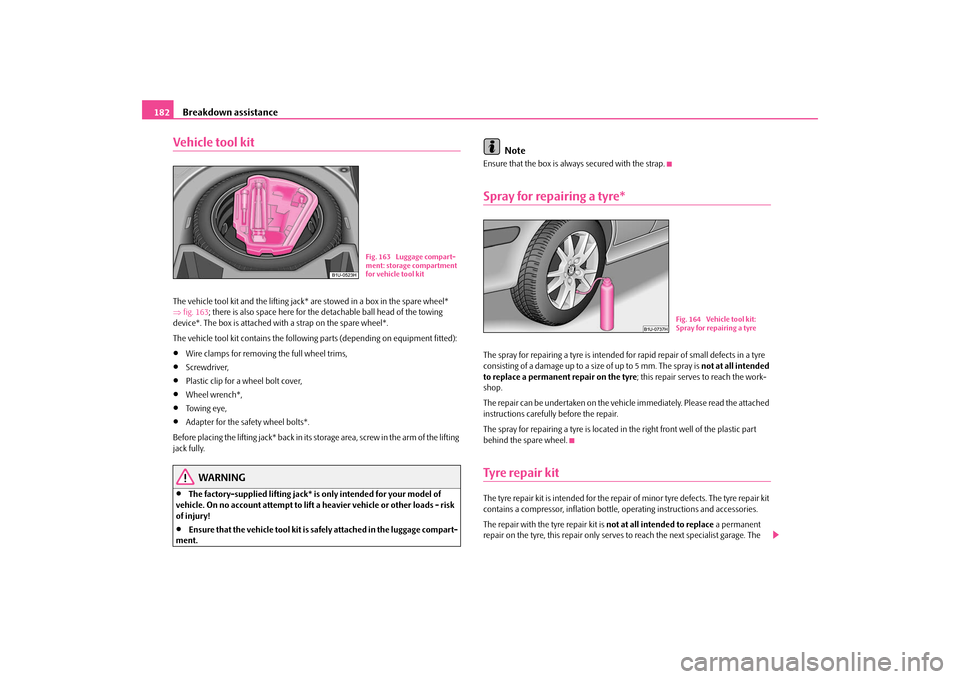
Breakdown assistance
182
Vehicle tool kitThe vehicle tool kit and the lifting jack* are stowed in a box in the spare wheel* ⇒ fig. 163
; there is also space here for the de
tachable ball head of the towing
device*. The box is attached with a strap on the spare wheel*. The vehicle tool kit contains the following parts (depending on equipment fitted):•
Wire clamps for removing
the full wheel trims,
•
Screwdriver,
•
Plastic clip for a wheel bolt cover,
•
Wheel wrench*,
•
Towing eye,
•
Adapter for the safety wheel bolts*.
Before placing the lifting jack* back in its
storage area, screw in the arm of the lifting
jack fully.
WARNING
•
The factory-supplied lifting jack* is
only intended for your model of
vehicle. On no account attempt to lift
a heavier vehicle or other loads - risk
of injury!•
Ensure that the vehicle tool kit is safely attached in the luggage compart-
ment.
Note
Ensure that the box is alwa
ys secured with the strap.
Spray for repairing a tyre*The spray for repairing a tyre is intended fo
r rapid repair of small defects in a tyre
consisting of a damage up to a si
ze of up to 5 mm. The spray is
not at all intended
to replace a permanent repair on the tyre
; this repair serves to reach the work-
shop. The repair can be undertaken on the vehicl
e immediately. Please read the attached
instructions carefully before the repair. The spray for repairing a tyre is located in
the right front well of the plastic part
behind the spare wheel.Tyre repair kitThe tyre repair kit is intended for the repair of minor tyre defects. The tyre repair kit contains a compressor, inflation bottle, operating instructions and accessories. The repair with the
tyre repair kit is
not at all intended to replace
a permanent
repair on the tyre, this repair only serves
to reach the next specialist garage. The
Fig. 163 Luggage compart- ment: storage compartment for vehicle tool kit
Fig. 164 Vehicle tool kit: Spray for repairing a tyre
s2g8.b.book Page 182 Tuesday, April 7, 2009 8:53 AM
Page 184 of 224
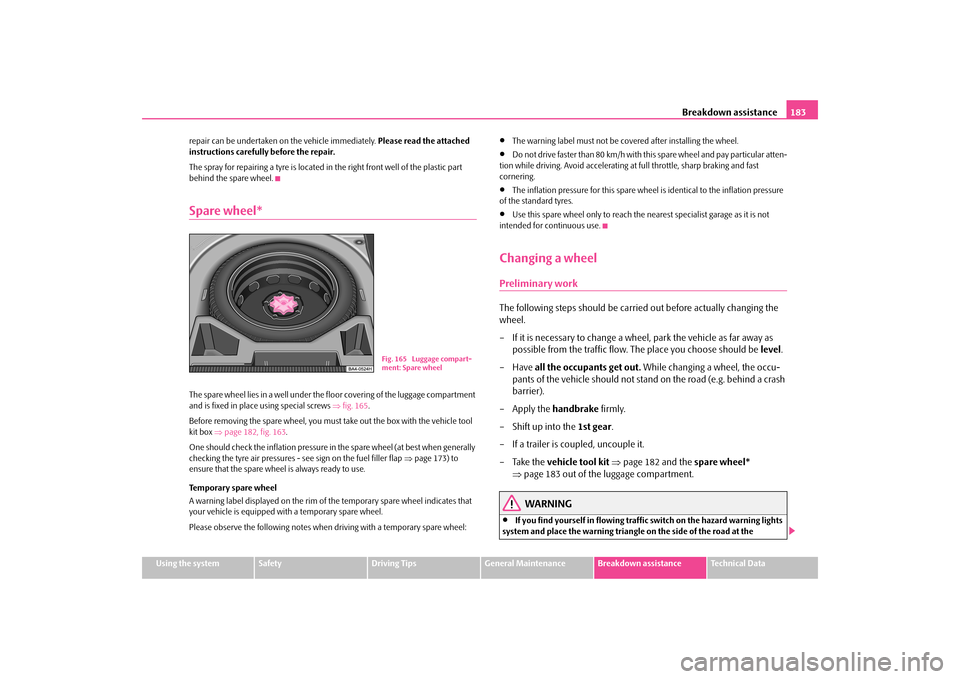
Breakdown assistance
183
Using the system
Safety
Driving Tips
General Maintenance
Breakdown assistance
Technical Data
repair can be undertaken on
the vehicle immediately.
Please read the attached
instructions carefully before the repair. The spray for repairing a tyre is located in
the right front well of the plastic part
behind the spare wheel.Spare wheel*The spare wheel lies in a well under the floor covering of the luggage compartment and is fixed in place using special screws
⇒fig. 165
.
Before removing the spare wheel, you must take out the box with the vehicle tool kit box
⇒page 182, fig. 163
.
One should check the inflation pressure in the spare wheel (at best when generally checking the tyre air pressures - see sign on the fuel filler flap
⇒page 173) to
ensure that the spare wheel is always ready to use. Temporary spare wheel A warning label displayed on the rim of the temporary spare wheel indicates that your vehicle is equipped with a temporary spare wheel. Please observe the following notes when driving with a temporary spare wheel:
•
The warning label must not be covered after installing the wheel.
•
Do not drive faster than 80 km/h with th
is spare wheel and pay particular atten-
tion while driving. Avoid accelerating at full throttle, sharp braking and fast cornering.•
The inflation pressure for this spare wheel is identical to the inflation pressure
of the standard tyres.•
Use this spare wheel only to reach the nearest specialist garage as it is not
intended for continuous use.Changing a wheelPreliminary workThe following steps should be carried out before actually changing the wheel. – If it is necessary to change a wheel, park the vehicle as far away as
possible from the traffic flow. The place you choose should be
level
.
–Have
all the occupants get out.
While changing a wheel, the occu-
pants of the vehicle should not stan
d on the road (e.g. behind a crash
barrier).
– Apply the
handbrake
firmly.
– Shift up into the
1st gear
.
– If a trailer is coupled, uncouple it. – Take the
vehicle tool kit
⇒
page 182 and the
spare wheel*
⇒
page 183 out of the luggage compartment.WARNING
•
If you find yourself in flowing traffic switch on the hazard warning lights
system and place the warning triangle
on the side of the road at the
Fig. 165 Luggage compart- ment: Spare wheel
s2g8.b.book Page 183 Tuesday, April 7, 2009 8:53 AM
Page 185 of 224
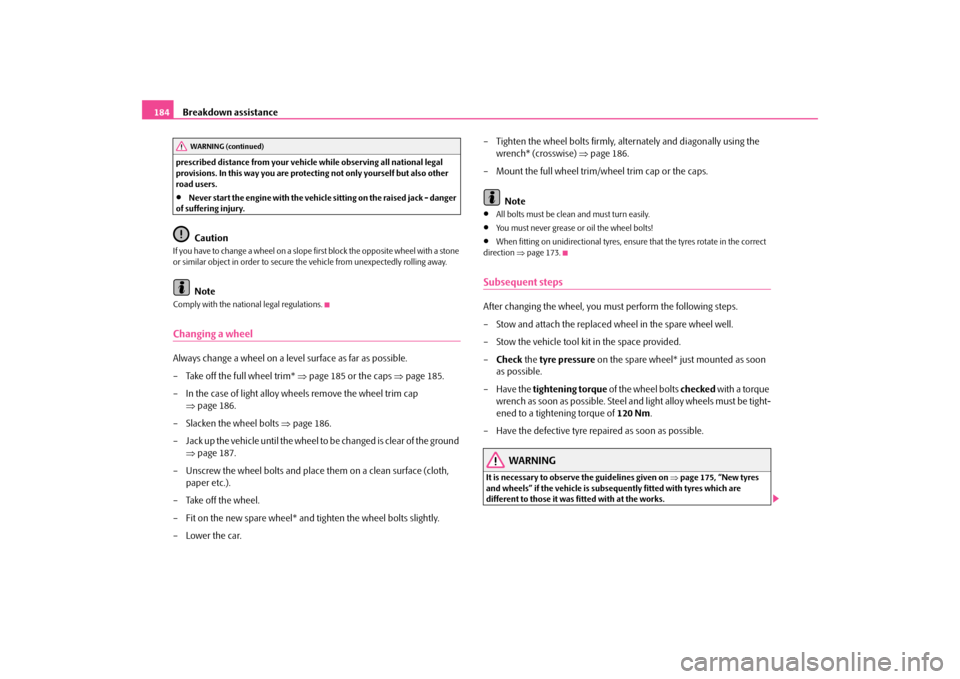
Breakdown assistance
184
prescribed distance from your vehicl
e while observing all national legal
provisions. In this way you are protecting not only yourself but also other road users.•
Never start the engine with the vehicle
sitting on the raised jack - danger
of suffering injury.
Caution
If you have to change a wheel on a slope
first block the opposite wheel with a stone
or similar object in order to secure th
e vehicle from unexpectedly rolling away.
Note
Comply with the national legal regulations.Changing a wheelAlways change a wheel on a level surface as far as possible. – Take off the full wheel trim*
⇒
page 185 or the caps
⇒
page 185.
– In the case of light alloy wheels remove the wheel trim cap
⇒
page 186.
– Slacken the wheel bolts
⇒
page 186.
– Jack up the vehicle until the wheel to
be changed is clear of the ground
⇒
page 187.
– Unscrew the wheel bolts and place them on a clean surface (cloth,
paper etc.).
– Take off the wheel.– Fit on the new spare wheel* and tighten the wheel bolts slightly. –Lower the car.
– Tighten the wheel bolts firmly, al
ternately and diagonally using the
wrench* (crosswise)
⇒
page 186.
– Mount the full wheel trim/w
heel trim cap or the caps.
Note
•
All bolts must be clean
and must turn easily.
•
You must never grease or oil the wheel bolts!
•
When fitting on unidirectional tyres, ensure that the tyres rotate in the correct
direction
⇒page 173.
Subsequent stepsAfter changing the wheel, you must perform the following steps. – Stow and attach the replaced wheel in the spare wheel well. – Stow the vehicle tool kit in the space provided.–
Check
the
tyre pressure
on the spare wheel* just mounted as soon
as possible.
– Have the
tightening torque
of the wheel bolts
checked
with a torque
wrench as soon as possible. Steel and light alloy wheels must be tight-ened to a tightening torque of
120 Nm
.
– Have the defective tyre repaired as soon as possible.
WARNING
It is necessary to observe the guidelines given on
⇒page 175, “New tyres
and wheels” if the vehicle is subseq
uently fitted with tyres which are
different to those it was fitted with at the works.
WARNING (continued)
s2g8.b.book Page 184 Tuesday, April 7, 2009 8:53 AM
Page 186 of 224
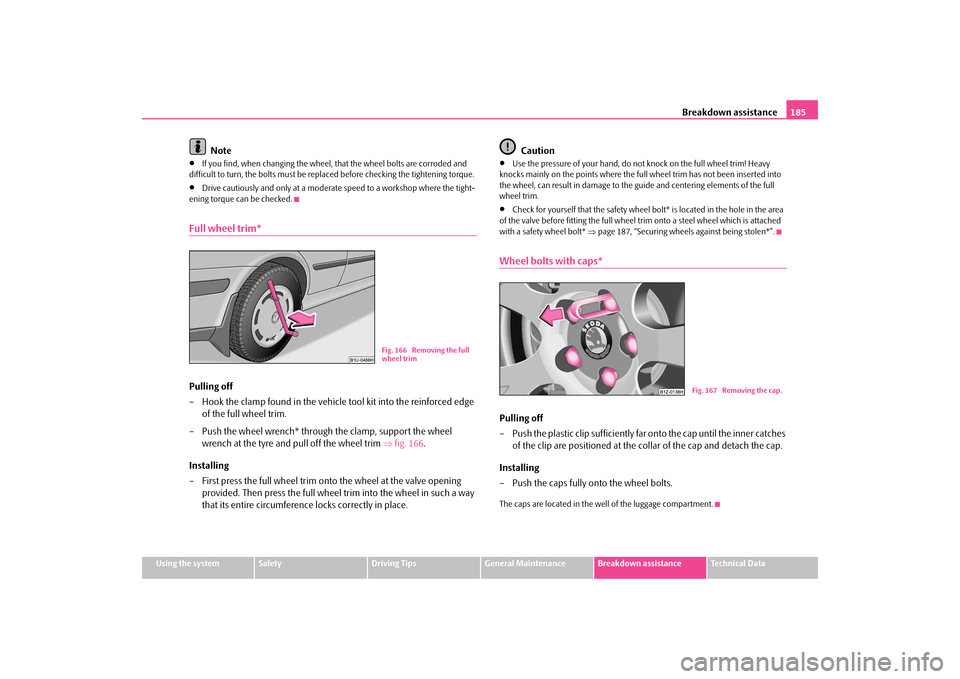
Breakdown assistance
185
Using the system
Safety
Driving Tips
General Maintenance
Breakdown assistance
Technical Data
Note
•
If you find, when changing the wheel,
that the wheel bolts are corroded and
difficult to turn, the bolts mu
st be replaced before chec
king the tightening torque.
•
Drive cautiously and only at a moderate speed to a workshop where the tight-
ening torque can be checked.Full wheel trim*Pulling off – Hook the clamp found in the vehicle tool kit into the reinforced edge
of the full wheel trim.
– Push the wheel wrench* through the clamp, support the wheel
wrench at the tyre and pull off the wheel trim
⇒
fig. 166
.
Installing – First press the full wheel trim onto the wheel at the valve opening
provided. Then press the full wheel trim into the wheel in such a way that its entire circumference locks correctly in place.
Caution
•
Use the pressure of your hand, do not knock on the full wheel trim! Heavy
knocks mainly on the points where the full wheel trim has not been inserted into the wheel, can result in damage to the guide and centering elements of the full wheel trim.•
Check for yourself that the safety wheel bo
lt* is located in the hole in the area
of the valve before fitting the full wheel tr
im onto a steel wheel which is attached
with a safety wheel bolt*
⇒page 187, “Securing wheels against being stolen*”.
Wheel bolts with caps*Pulling off – Push the plastic clip sufficiently fa
r onto the cap until the inner catches
of the clip are positioned at the collar of the cap and detach the cap.
Installing – Push the caps fully onto the wheel bolts.The caps are located in the we
ll of the luggage compartment.
Fig. 166 Removing the full wheel trim
Fig. 167 Removing the cap.
s2g8.b.book Page 185 Tuesday, April 7, 2009 8:53 AM
Page 187 of 224
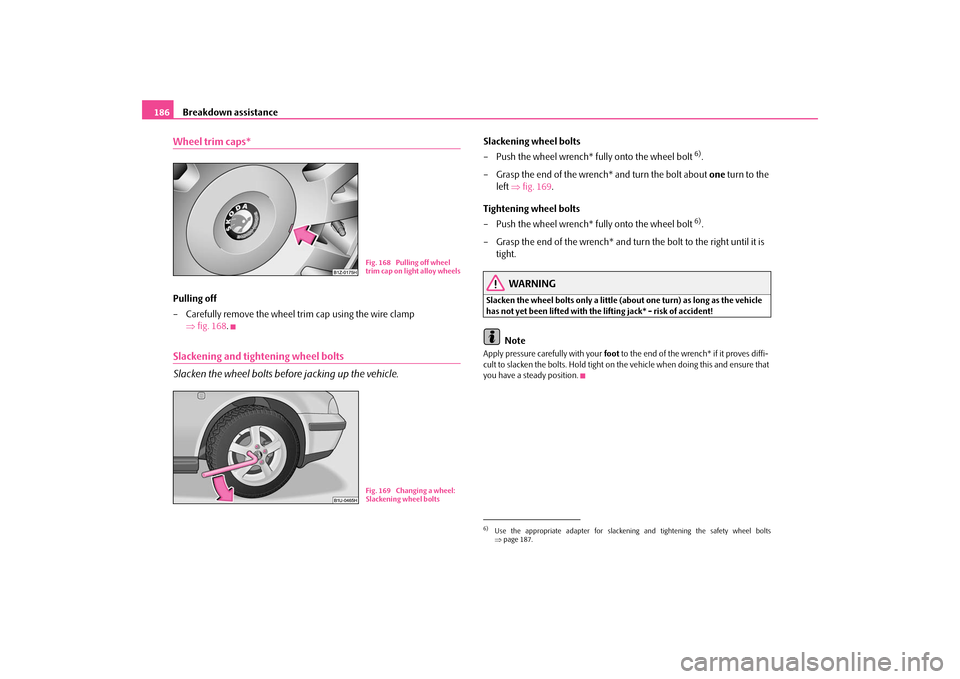
Breakdown assistance
186
Wheel trim caps*Pulling off – Carefully remove the wheel tr
im cap using the wire clamp
⇒
fig. 168
.
Slackening and tightening wheel bolts Slacken the wheel bolts before jacking up the vehicle.
Slackening wheel bolts – Push the wheel wrench* fully onto the wheel bolt
6).
– Grasp the end of the wrench* and turn the bolt about
one
turn to the
left
⇒
fig. 169
.
Tightening wheel bolts – Push the wheel wrench* fully onto the wheel bolt
6).
– Grasp the end of the wrench* and turn the bolt to the right until it is
tight.
WARNING
Slacken the wheel bolts only a little (a
bout one turn) as long as the vehicle
has not yet been lifted with the lifting jack* - risk of accident!
Note
Apply pressure carefully with your
foot
to the end of the wrench* if it proves diffi-
cult to slacken the bolts. Hold tight on th
e vehicle when doing this and ensure that
you have a steady position.
Fig. 168 Pulling off wheel trim cap on light alloy wheelsFig. 169 Changing a wheel: Slackening wheel bolts
6)Use the appropriate adapter for slackening
and tightening the safety wheel bolts
⇒ page 187.
s2g8.b.book Page 186 Tuesday, April 7, 2009 8:53 AM
Page 188 of 224
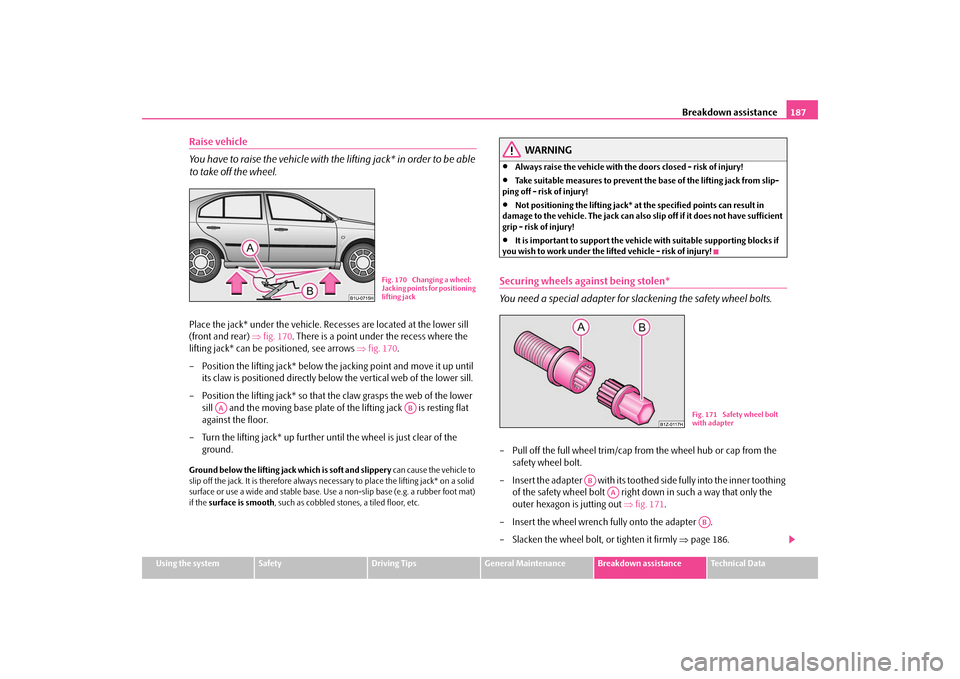
Breakdown assistance
187
Using the system
Safety
Driving Tips
General Maintenance
Breakdown assistance
Technical Data
Raise vehicle You have to raise the vehicle with the lifting jack* in order to be able to take off the wheel.Place the jack* under the vehicle. Re
cesses are located at the lower sill
(front and rear)
⇒
fig. 170
. There is a point under the recess where the
lifting jack* can be po
sitioned, see arrows
⇒
fig. 170
.
– Position the lifting jack* below the jacking point and move it up until
its claw is positioned di
rectly below the vertical web of the lower sill.
– Position the lifting jack* so that the claw grasps the web of the lower
sill and the moving base plate of
the lifting jack is resting flat
against the floor.
– Turn the lifting jack* up further until the wheel is just clear of the
ground.
Ground below the lifting jack which is soft and slippery
can cause the vehicle to
slip off the jack. It is therefore always ne
cessary to place the lifting jack* on a solid
surface or use a wide and stable base. Use
a non-slip base (e.g. a rubber foot mat)
if the
surface is smooth
, such as cobbled stones, a tiled floor, etc.
WARNING
•
Always raise the vehicle with the doors closed - risk of injury!
•
Take suitable measures to prevent the
base of the lifting jack from slip-
ping off - risk of injury!•
Not positioning the lifting jack* at
the specified points can result in
damage to the vehicle. The jack can also sl
ip off if it does not have sufficient
grip - risk of injury!•
It is important to support the vehicle with suitable supporting blocks if
you wish to work under the lifted vehicle - risk of injury!Securing wheels against being stolen* You need a special adapter for slackening the safety wheel bolts.– Pull off the full wheel trim/cap from the wheel hub or cap from the
safety wheel bolt.
– Insert the adapter with its toothed side fully into the inner toothing
of the safety wheel bolt right down in such a way that only the outer hexagon is jutting out
⇒
fig. 171
.
– Insert the wheel wrench fully onto the adapter . – Slacken the wheel bolt, or tighten it firmly
⇒
page 186.
Fig. 170 Changing a wheel: Jacking points for positioning lifting jack
AA
AB
Fig. 171 Safety wheel bolt with adapter
AB
AA
AB
s2g8.b.book Page 187 Tuesday, April 7, 2009 8:53 AM
Page 189 of 224
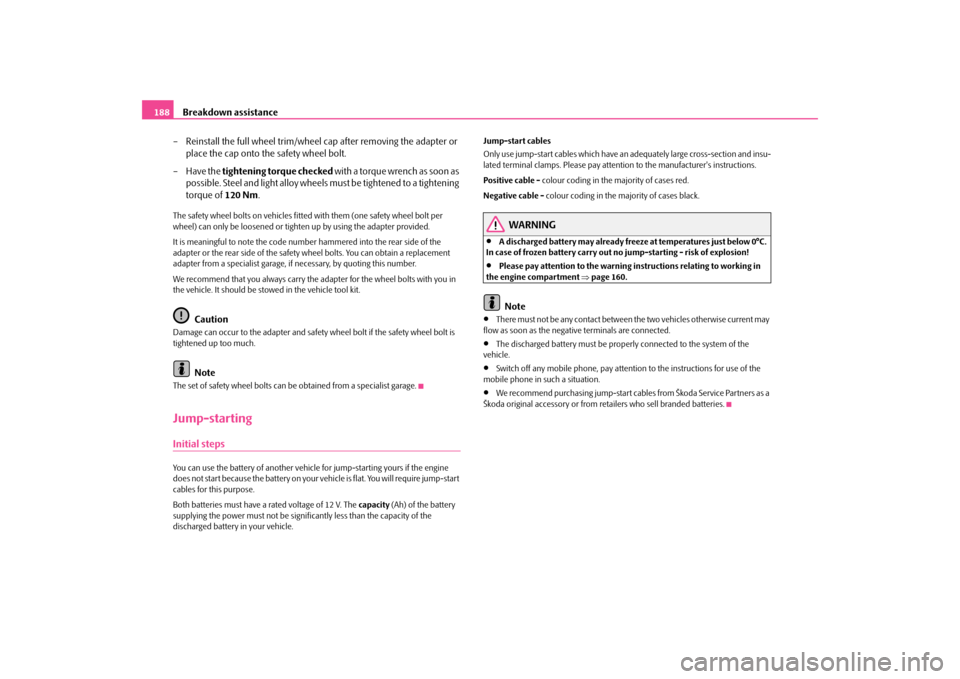
Breakdown assistance
188
– Reinstall the full wheel trim/wheel cap after removing the adapter or
place the cap onto the safety wheel bolt.
– Have the
tightening torque
checked
w i t h a t o rq u e w re n c h a s s o o n a s
possible. Steel and light alloy wheels must be tightened to a tightening torque of
120 Nm
.
The safety wheel bolts on vehicles fitted with them (one safety wheel bolt per wheel) can only be loosened or tigh
ten up by using the adapter provided.
It is meaningful to note the code numbe
r hammered into the rear side of the
adapter or the rear side of the safety wheel bolts. You can obtain a replacement adapter from a specialist garage, if
necessary, by quoting this number.
We recommend that you always carry the
adapter for the wheel bolts with you in
the vehicle. It should be st
owed in the vehicle tool kit.
Caution
Damage can occur to the adapter and safety
wheel bolt if the safety wheel bolt is
tightened up too much.
Note
The set of safety wheel bolts can be
obtained from a specialist garage.
Jump-startingInitial stepsYou can use the battery of another vehicl
e for jump-starting yours if the engine
does not start because the battery on your
vehicle is flat. You will require jump-start
cables for this purpose. Both batteries must have a rated voltage of 12 V. The
capacity
(Ah) of the battery
supplying the power must not be significa
ntly less than the capacity of the
discharged battery in your vehicle.
Jump-start cables Only use jump-start cables which have an
adequately large cross-section and insu-
lated terminal clamps. Please pay attent
ion to the manufacturer's instructions.
Positive cable -
colour coding in the
majority of cases red.
Negative cable -
colour coding in the majority of cases black.
WARNING
•
A discharged battery may already freeze
at temperatures just below 0°C.
In case of frozen battery carry out no jump-starting - risk of explosion!•
Please pay attention to the warning instructions relating to working in
the engine compartment
⇒page 160.
Note
•
There must not be any contact between the two vehicles otherwise current may
flow as soon as the negative terminals are connected.•
The discharged battery must be proper
ly connected to the system of the
vehicle.•
Switch off any mobile phone, pay attent
ion to the instructions for use of the
mobile phone in such a situation.•
We recommend purchasing jump-start cabl
es from Škoda Service Partners as a
Škoda original accessory or from retailers who sell branded batteries.
s2g8.b.book Page 188 Tuesday, April 7, 2009 8:53 AM
Page 190 of 224
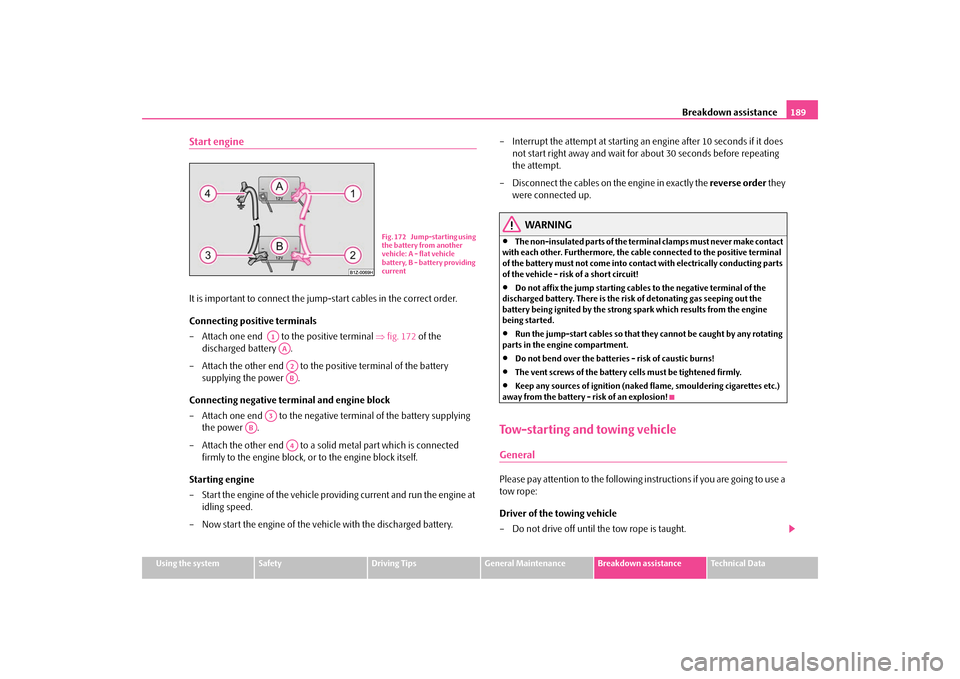
Breakdown assistance
189
Using the system
Safety
Driving Tips
General Maintenance
Breakdown assistance
Technical Data
Start engineIt is important to connect the jump
-start cables in the correct order.
Connecting positive terminals – Attach one end to the positive terminal
⇒
fig. 172
of the
discharged battery .
– Attach the other end to the positive terminal of the battery
supplying the power .
Connecting negative term
inal and engine block
– Attach one end to the negative
terminal of the battery supplying
the power .
– Attach the other end to a solid metal part which is connected
firmly to the engine block, or
to the engine block itself.
Starting engine – Start the engine of the vehicle providing current and run the engine at
idling speed.
– Now start the engine of the vehicle with the discharged battery.
– Interrupt the attempt at starting an engine after 10 seconds if it does
not start right away and wait for about 30 seconds before repeating the attempt.
– Disconnect the cables on the engine in exactly the
reverse order
they
were connected up.
WARNING
•
The non-insulated parts of the terminal clamps must never make contact
with each other. Furthermore, the cable connected to the positive terminal of the battery must not come into contact with electrically conducting parts of the vehicle - risk of a short circuit!•
Do not affix the jump starting cables to the negative terminal of the
discharged battery. There is the risk
of detonating gas seeping out the
battery being ignited by the strong
spark which results from the engine
being started.•
Run the jump-start cables so that th
ey cannot be caught
by any rotating
parts in the engine compartment.•
Do not bend over the batteries - risk of caustic burns!
•
The vent screws of the battery cells must be tightened firmly.
•
Keep any sources of ignition (naked
flame, smouldering cigarettes etc.)
away from the battery - risk of an explosion!Tow-starting and towing vehicleGeneralPlease pay attention to the following in
structions if you are going to use a
tow rope: Driver of the towing vehicle – Do not drive off until the tow rope is taught.
Fig. 172 Jump-starting using the battery from another vehicle: A - flat vehicle battery, B - battery providing current
A1AAA2AB
A3
AB
A4
s2g8.b.book Page 189 Tuesday, April 7, 2009 8:53 AM